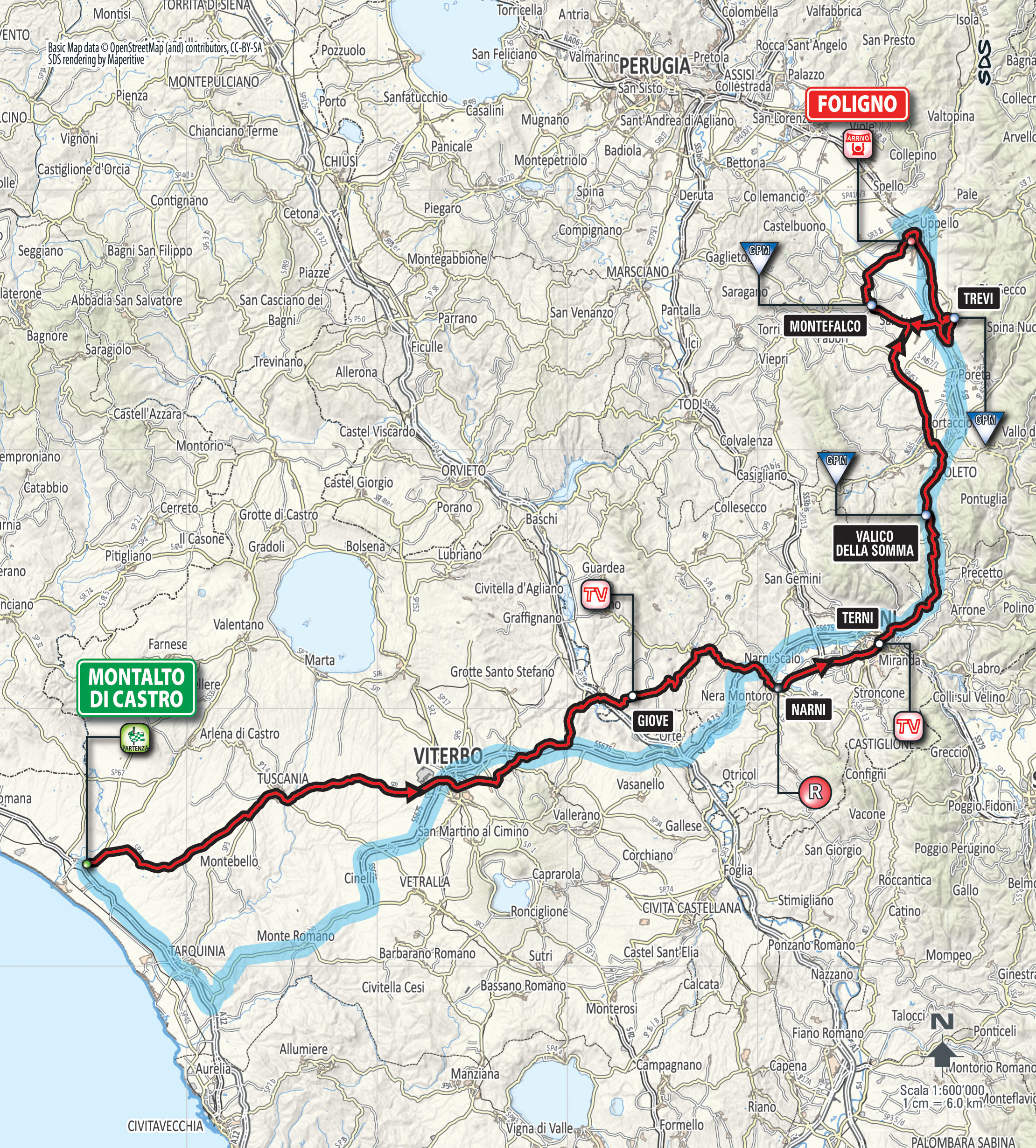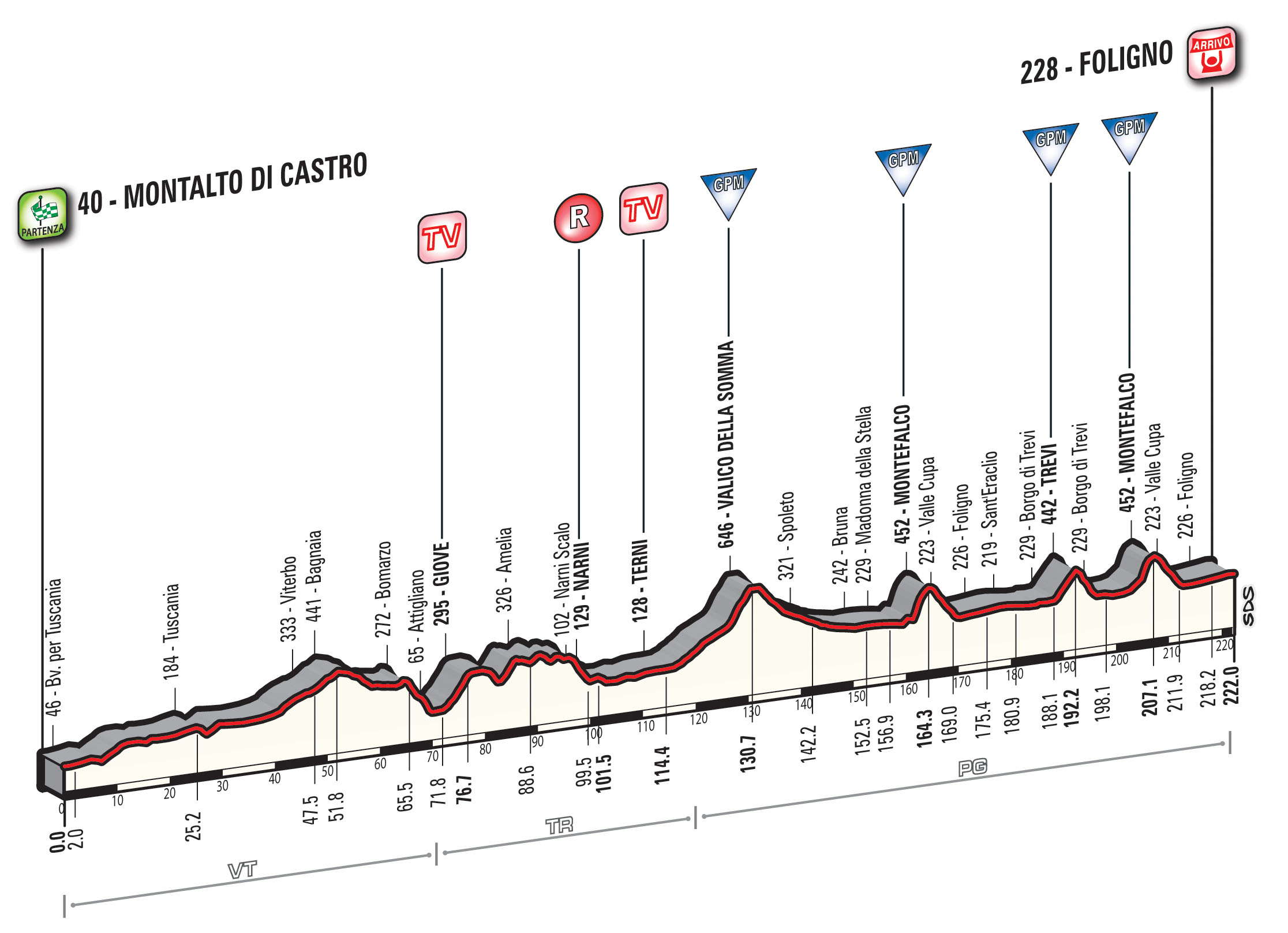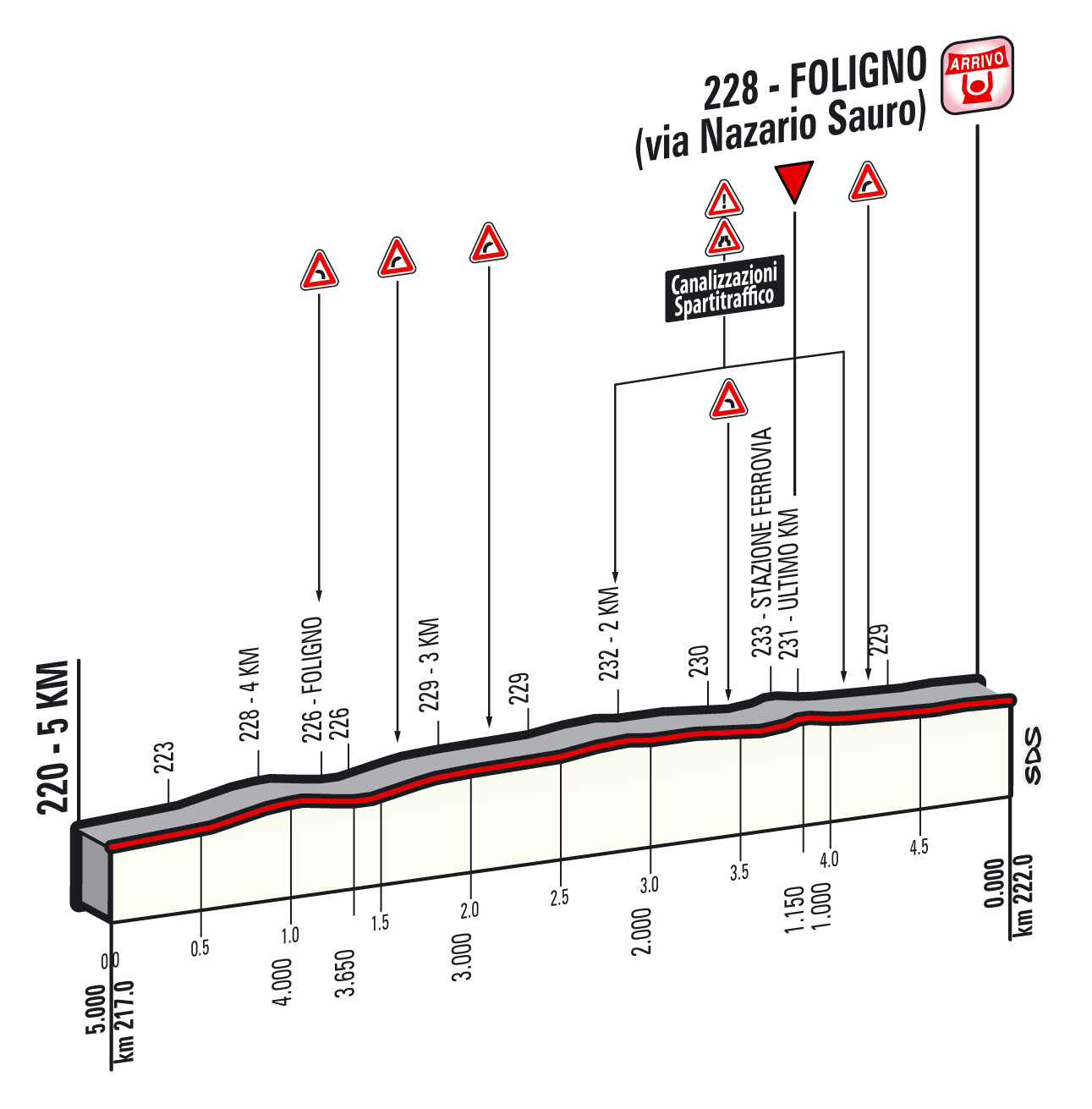After one day for the sprinters, the classics riders will again come to the fore in stage 4 which offers some of the short, irregular and very steep climbs that have always characterized Tirreno-Adriatico. While the GC riders will try to save energy for the queen stage, Peter Sagan will target that elusive first win in the rainbow jersey on a stage that is likely to be decided in a reduced bunch sprint.
The course
In the last few years, the GC riders have had two chances to make a difference on the climbs but this year there is only one real opportunity. The fourth stage has often been a day that could create gaps between some of the best riders but that is unlikely to happen in 2016 as the course for the midpoint stage is significantly easier than it has been in the last few years. Nonetheless, it includes some significant climbing over a very long distance, making it another perfect test for the many classics riders that are gathered in Italy.
This is the first stage of the 2016 Tirreno-Adriatico featuring remarkably harsh climbs. Measuring 222km in length, it is also the longest one that brings the riders from Montalto di Castro close to the Tyrrhenian coast to Foligno. After three days spent travelling along the coast, it is time to start the journey to the Adriatic Sea. Hence, the riders will head straight into the interior of the country, travelling in a northeasterly direction for most of the day until they turn north to approach the finishing city in the hillier final part.
The route leads through the province of Viterbo, hitting the provincial capital, as well as Tuscania and Bagnaia. After a flat stat, the road gets a bit lumpier, most notably at the uphill intermediate sprint after 76.7km of racing but there are no significant climbs in the first half of the race until the riders get to the second intermediate sprint at the 114.4km mark.
The stage finale is marked by a series of ascents and descents. After the Giove climb at the first intermediate sprint, the route reaches Amelia and Acquasparta, and then it tackles the Valico di Colle Cerquiglie categorized climb (6.7km, 4.9%, max. 8%) whose summit is located at the 130.7km mark. Then a long descending secton leads to the finishing circuit which the riders hit just before they get to the main climb of Montefalco.
The long, wide, final circuit (46.6km) features a steep climb up Montefalco (5.5km, 4.1%, max. 18%, long stretches with gradients of over 12%), followed by a passage close to the finish line, another categorized climb in Trevi (4.0km, 5.3%, max. 16%) and then one final passage of Montefalco with 14.9km to go. The climbs are separated by long, flat sections. The route then drops down into Foligno, heading for the finish line along flat roads.
The last kilometres are quite uncomplicated, up to 2,000 metres to the finish. Here, a left-hand bend immediately followed by two right-hand bends just before the flamme rouge lead to the home stretch, with just a mild bend with 500m left to go. Then there’s another sweeping turn that leads to the finish line which lies on a 160-m long and 7-m wide asphalt straight road.
Foligno last hosted a stage in 2003 when Mario Cipollini won a much easier stage in a bunch sprint. The sprinters also came to the fore in the 2014 Giro d’Italia where Nacer Bouhanni came out on top in another bunch kick.



The weather
The pleasant weather which has characterized the first part of the race will continue for another day. Saturday is forecasted to be sunny with a maximum temperature at the finish of 13 degrees.
There will be a moderate wind from a northeasterly direction which means that the riders will have a headwind for most of the day. They will turn into a cross-headwind at the bottom of the first climb. On the circuit , there will be a headwind on the Trevi climb, a crosswind on Montefalco and a headwind on the run back to the finish. In the technical finale, there will both be cross- and tailwind sections. It will be a crosswind sprint.
The favourites
It has been a well-known fact for a long time that Fernando Gaviria and Caleb Ewan are the two most exciting sprinting talents but opinions have been divided about who’s the fastest of the pair. Today they finally clashed for the first time and as expected it turned out to be a close one. Gaviria lived up to our expectations by taking a narrow win but there’s a lot more to come from those two riders in the future. At the same time, it was impressive to see how they made a star-studded sprint field almost look like junior riders which fully confirms that they are destined to dominate the sprints in a few years.
For the rest of the field, stage 3 was a relatively calm one which was mostly about avoiding any dangers and staying safe in the wind and on the tricky descent from the first climb. Traditionally, the GC riders have been trying to save energy for two GC days but this year they will have to bide their time for another day. There is little doubt that that stage 4 is a tough one and it may turn out to be harder than it looks on paper but with a long, flat stretch and a headwind in the final part, it won’t be possible for them to make a difference.
Instead, the classics riders will be eyeing this one. Stage 5 is a mountain stage and stage 6 is for the sprinters so this is their final chance to get a victory. However, there will be come uncertainty about the nature of the finale. The roadbook doesn’t offer much information about the climbs in Trevi and Montefalco but their average gradients are not frightening. However, they include some very steep sections and knowing the terrain in this part of the country, they are likely to be much tougher than they look on paper. Both are on narrow roads and the information we can gather, indicate that they are some of those very steep, irregular climbs that have often split this race to pieces.
This is Peter Sagan’s best chance to win a stage in the remaining part of the race so Tinkoff have to take come initiative. They have not done much yet but they can’t let this opportunity slip away. Etixx-QuickStep will probably mostly focus on the defence of the jersey so if the early break has no really dangerous riders, they may let it stay away. Hence, Tinkoff have to come to the fore and we expect them to do so. It’s also a good stage for Edvald Boasson Hagen and so Dimension Data will probably lend them a hand. There is a small chance for the break so we should have a little fight early in the stage but when the break has been formed, we expect Dimension Data, Tinkoff and Etixx-QuickStep to slowly reel them in.
It will be a long day in the headwind and it will all come down to the final circuit. With the narrow roads, there will be a huge fight for position at the bottom of every climb as positioning is just as important as climbing skills. The first passage of Montefalco is unlikely to make much of a difference apart from making a first selection but we can expect attacks on the final lap. The GC contenders know that it will require a massive effort to stay away so they will probably save energy for tomorrow but it would be no surprise to see lieutenants like Giovanni Visconti and Daniel Moreno give it a go. Furthermore, we expect Cannondale to ride aggressively with Davide Formolo, Rigoberto Uran and Simon Clarke as they are now out of the GC battle and we can expect the usual aggressiveness from a rider like Jose Goncalves too.
There will be a headwind in the finale so it will be very hard to stay away but much will depend on the kind of support that riders like Sagan and Boasson Hagen have after the final climb. We expect it to be more selective than one would initially expect so there won’t be many domestiques left. Roman Kreuziger will have to save energy for the queen sage so Sagan has to hope for Oscar Gatto and Manuele Boaro to survive. Boasson Hagen hopes for Reinardt van Rensburg, Kantsnatsin Siutsou, Natnael Berhane and Stephen Cummings and it could be the relatively strong Dimension Data team that makes the difference. BMC will also lend a hand with Damiano Caruso, Alessandro De Marchi and Daniel Oss so we expect t a reduced bunch sprint but a strong late breakaway cannot be ruled out.
If it comes down to a sprint, Peter Sagan will be the man to beat. The Slovakian has proved that he is faster than Boasson Hagen and he should find this stage to his liking. While he may suffer a bit on longer climbs, he really likes short, steep ascents and he has even won the very hard Chieti stage in this race. Last year he was dropped in a similar stage but back then he was at a far lower level. We don’t think that he will be distanced here and he will find the relatively technical finale to his liking. He has been beaten by Greg Van Avermaet on a number of occasions but in a flat sprint he is clearly faster. Sagan is our favourite to win.
His big rival will be Edvald Boasson Hagen. The Norwegian is back at his best level and confirmed it in stage 2 where he was one of the strongest on the final climb. However, he is a bit different than Sagan and doesn’t seem to have the same power as the Slovakian when it gets really steep. He may be a bit too big if this stage gets really tough. On the other hand, he is a better climber than Sagan on longer climbs. This stage should be manageable for Boasson Hagen and he is able to beat most in a sprint. If he even has van Rensburg for the lead-out, he won’t be easy to beat. On paper, Sagan may be slightly faster but it will be a close battle.
Fernando Gaviria is the big dark horse. The Colombian is much more than a sprinter as he climbs really well too. He is not at Sagan’s or Boasson Hagen’s level but the full extent of his potential is still unknown. He has mostly been riding on the track and so hasn’t done much climbing so we expect him to get distanced. However, we won’t rule him out and if he is there at the finish, it will be piece of cake for him to win the sprint.
Greg Van Avermaet won a stage last year and this is now his final opportunity. He can both go on the attack on the climbs and wait for the sprint but we expect him to ride defensively as he has so much confidence after having beaten Sagan on a number of occasions. He will have great team support in the finale but on paper he doesn’t have the speed to beat Sagan and Boasson Hagen in a flat sprint.
We were pretty surprised to see Fabian Cancellara miss out in stage 2 and there is no guarantee that the in-form Swiss will be going for victory here. These climbs could be too steep for him but his form is great so it won’t be impossible for him to survive. People tend to forget that he is very fast in a sprint as he has proved numerous times in Milan-Sanremo. He can also make a late attack in the technical finale where it will be difficult to control things.
Francesco Gavazzi is really fast in a sprint and should like this stage. If the pace on the climbs is really fast, it could be too tough for him but we expect him to survive. It will be hard to beat Sagan and Boasson Hagen but he has won this kind of reduced bunch sprints in the past.
A rider that can potentially win a reduced bunch sprint is Sonny Colbrelli. He is climbing better than ever and has been really impressive this year. However, the WorldTour level was a bit tough for him in stage 2 and we expect him to get dropped here. If he makes it, he will be one of the riders with a chance to win.
If the stage gets really tough, Alejandro Valverde will have a chance. The Spaniard has won bunch sprints in the past and can beat most in a flat sprint. However, he is not as fast as he once was and he won’t take too many risks. On the other hand, there are bonus seconds up for grabs so he should give it a shot. Michal Kwiatkowski and Tiesj Benoot will also be keen to try in a sprint.
For more fast riders, keep an eye on Jasper Stuyven, Simone Ponzi, Zdenek Stybar, Leigh Howard, Diego Ulissi, Sergey Chernetskii and Enrico Battaglin.
As said, a strong break on the final circuit has a chance but only if it is made up of riders that are no real GC dangers. Movistar are likely to play the Giovanni Visconti card. He attacked in stage 2, likes this terrain and is fast in a sprint.
Cannondale are eager to bounce back and have Rigoberto Uran, Simon Clarke and Davide Formolo. They are all riding really well and the former two have the sprinting skills to do well both from a breakaway and a reduced bunch sprint. Benoot and Jan Bakelants are also strong breakaway candidates as are Lars Petter Nordhaug, Andriy Grivko and Joaquim Rodriguez.
CyclingQuotes’ stage winner pick: Peter Sagan
Other winner candidates: Edvald Boasson Hagen, Fernando Gaviria
Outsiders: Greg Van Avermaet, Fabian Cancellara, Francesco Gavazzi
Jokers: Matteo Trentin, Sonny Colbrelli, Alejandro Valverde, Michal Kwiatkowski, Jasper Stuyven, Leigh Howard, Sergey Chernetskii
Candidates for late breakaway: Giovanni Visconti, Rigoberto Uran, Simon Clarke, Davide Formolo, Tiesj Benoot, Jan Bakelants, Lars Petter Nordhaug, Andriy Grivko, Joaquim Rodriguez
| Matthias LEGLEY 34 years | today |
| Asbjørn HELLEMOSE 26 years | today |
| Eelke VAN DER WAL 44 years | today |
| Christiane SOEDER 50 years | today |
| Denis OROZCO 40 years | today |
© CyclingQuotes.com









